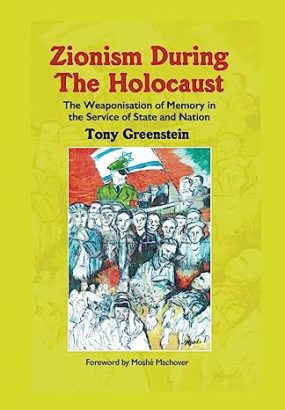Zionism During the Holocaust: The Weaponisation of Memory in the Service of State and Nation is perhaps the worst book I’ve ever read. It has little narrative flow, doesn’t consist of a full review of the work undertaken by the Zionist movement against the Nazis, offers little to nothing in the way of context for the actions described by the author and is filled with contradictions and even antisemitic assertions.
In his introduction Greenstein claims that ‘Zionist criticism of this book, however shrill, will make little or no reference to its contents’ and in his conclusion that ‘this book and its author will no doubt be heavily criticised by Zionism’s propagandists while ignoring the content.’ Perhaps Greenstein makes these claims because he’s essentially written a book about Zionism during the Holocaust that ignores the work that the Zionist movement, be that the Jewish Agency Executive in Palestine or the Board of Deputies in Great Britain, or the Zionist world more generally did to fight Hitler. It also ignores the challenges faced by the Zionist movement in their efforts to convince the major powers to direct their efforts towards helping Jews at their moment of greatest need. In any case, it appears that he was wrong in his assertions because this Zionist ‘propagandist’ will indeed be looking at the content, mainly so that you don’t have to.
Essentially, Greenstein’s argument in the book is that there was a ‘Zionist policy of obstructing the attempts of others to provide a safe haven to Jewish refugees’, an accusation I find both ludicrous and false. In terms of who is at fault in the Holocaust he writes that ‘The charge of collaboration should though be primarily applied to the Zionist leadership in Palestine and not to the behaviour of individuals living under Nazi occupation’. Greenstein then goes on to ignore his own assertion throughout the book. He does it when discussing the German Zionist group ZVfD and when discussing Hungarian Jewry, especially Rudolf Kasztner, and usually when he mentions the Judenrate and Zionists in occupied countries. To support his perspective he offers quotes from prominent figures in the Zionist movement and connects them with some actions by various Jewish groups from different parts of the world. So far as I can see, many of his quotes serve to obscure the meaning of the sources they’ve been taken from and fail to offer serious proof to substantiate his claims against the ‘Zionist movement’.
While it appears on the surface that Greenstein has managed to omit every substantive act of resistance Zionists took against the Nazis he has been forced to include some aspects of their fight. For instance, in his section entitled ‘The Zionist Silence about the Hungarian Holocaust’ (p. 181) he references ‘Ehud Avriel, who was involved with Aliyah Bet’ being in Istanbul cabling information on the situation of Hungarian Jewry to Jerusalem. A few lines later he refers to ‘Vanya Pomerantz of the Agency’s Istanbul Mission’. But Greenstein never explains what the Istanbul Mission was, who Avriel and Vanya Pomerantz were or what Aliyah Bet was. This is a shame given the work of Avriel, Pomerantz and others such as Teddy Kollek who were sent to Istanbul and tasked with conducting operations to help Jews trapped in the Third Reich and countries allied to Germany. One could be forgiven for being surprised that such things have been left out of the book, bearing in mind its title.
Another nugget of information as to what Zionists actively did to help Jews during the Holocaust is buried in the section on Hungary entitled ‘The Affair of the Parachutists’. Here he notes that Haganah agents were dropped by the British into German occupied territory. Greenstein gives this episode short shrift by claiming ‘The 32 agents who were sent to Europe were unlikely to have any effect on the capabilities of the already extant resistance. Their true purpose was to reconstruct the crumbling youth movements there after the war.’ For me, this episode serves as an interesting insight into Zionism during the Holocaust. It shows that the Jewish Agency Executive succeeded in convincing the British to drop Jews from Palestine behind enemy lines to carry out operations that might help Jews. For Greenstein, apparently it does not. It’s worth highlighting this absence of conversation about the various plans and acts of resistance against the Nazis that emanated from the Jewish Agency Executive during the war. Greenstein seems to favour things he can use to serve a different perspective.
Perhaps the most notable omission is in Greenstein’s comments about the Kindertransport (p. 296) of which he claims ‘9,354 children were brought to England in the Kindertransport despite Zionist hostility. The Zionist leaders instead demanded that the children be brought to Palestine, which the Colonial Office rejected.’ This is an odd thing to say bearing in mind that the best known Zionist figure in the world at the time, Chaim Weizmann, together with Lionel de Rothschild founded the Central British Fund for German Jewry, the organisation that organised the Kindertransport. Both men personally lobbied Chamberlain to allow the children to come to Britain.
Eight pages are spent on the Warsaw ghetto uprising, but Greenstein is more engaged with attacking Zionism than portraying the uprising. The head of the resistance in the Warsaw Ghetto was Mordechai Anielewicz a leader of the Zionist youth movement Hashomer Hatzair. Greenstein downplays this link by writing that: ‘It was despite not because of, their Zionist politics that the young Zionists participated in the resistance.’ He also claims that ‘Mordechai Anielewicz of Hashomer Hatzair commanded the Jewish resistance because he had had military training.’ However, there were plenty of people in the ghetto with military training; there were few leaders of Hashomer Hatzair.
Apparently unable to deny the extent of Zionist Jewish resistance to the Nazis in the ghetto Greenstein seems to attempt to undermine the significance of the Zionism to the fighters yet, as he himself points out, during the uprising in the ghetto ‘for two days both the Polish and Star of David flags flew, visible to thousands of Poles’ what he doesn’t mention is that the Star of David flag was the blue and white flag of the Zionists. How did it get there? Who raised that flag if the fighters were waning in their Zionist politics? Questions that have no answers.
The book is 546 pages long and is split into three main parts; Zionism before the Holocaust, Zionism during the Holocaust and Zionism after the Holocaust. The second section is the longest coming in at 290 pages. I found the first section almost unreadable and put the book down after a mere 30 pages before giving it another go a month later. I finally found my way through it by treating each paragraph as if it were its own point without any connection to what went before or comes after. These two paragraphs from page 48 are as good an example as any:
Zionist Jewish identity plunders the bible for legitimacy. It is Joshua Bin Nun, who slaughtered even children and infants, who is a Zionist hero not the prophet Isaiah whose injunction to ‘Learn to do what is right, promote justice and give the oppressed reason to celebrate!’ is not part of the Zionist catechism. The welcome of strangers has no part in Zionist theology. Israel sees non-Jewish refugees as diluting the purity of the Jewish volk.
The lack of any social or economic basis to diaspora Jewry has led to its numerical decline. Zionism and Israel are insufficient to counter the attractions of secular society. Zionism in the West appeals to a small band of nationalist zealots suspended between Scylla and Charybdis.
From the start, Greenstein’s contention is that ‘the Zionist movement was eager to collaborate with the Nazis’. One issue for me was that it’s never quite clear what the ‘Zionist movement’ is. For example, towards the end of the book Greenstein claims that an Argentine, Jacobo Timerman, who fled the regime for Israel in the late 1970s ‘came under attack from the Zionist movement’. Greenstein’s rationale for making this claim is that ‘the Jewish Chronicle’s correspondent in Argentina’ wrote an article about him entitled ‘Timerman Stirs Jewish Discord’.
Indeed, Greenstein fails to define the terms ‘Zionist’, ‘Zionist movement’ or ‘Holocaust’ making it difficult for the reader to gain clarity on who, specifically, he is referring to in any given passage. An example of this confusion can be found at the very start of the book on page xviii, where he asserts that ‘Just because the Zionist movement collaborated with the Nazis this did not mean that ordinary Zionists did so.’ One must ask at what point an ‘ordinary Zionist’ becomes a part of ‘the Zionist movement’? The reader is never told.
At several points Greenstein contradicts himself. He writes in his introduction that ‘Although the Zionist record was shocking, the responsibility for the Holocaust was that of the Nazis alone. It was they who built the extermination camps, created the ghettos and organised the deportation trains’, only to write on the next page that:
Some will argue that only the Nazis bore moral responsibility for the Holocaust. That however excuses the behaviour of those who placed obstacles in it the path of rescue or who helped undermine resistance … In opposing the rescue of Jews to anywhere but Palestine, the Zionist movement cut the firehoses that could have saved the lives of hundreds of thousands of Jews. As such the Zionist movement bears a heavy moral responsibility for what happened.
In the book’s conclusion he claims that ‘Even if the Zionist movement had not existed then many if not most of Hitler’s Jewish victims would have perished.’
He writes in his introduction (p xviii): ‘In fact Zionism was a political minority everywhere in the Jewish world before World War II.’ But on page 145 he claims that ‘The Judenrate were composed of the traditional leadership, over two thirds of whom (67.1 per cent) consisted of Zionist supporters of all factions. The Zionists were an integral part of the traditional Jewish leadership in Eastern Europe.’ One wonders how both these things can be true. Perhaps this is a case of an author who is determined to prevent the facts from standing in the way of his beliefs?
When it comes to the word ‘Holocaust’ on page 81 he writes ‘of the 5.7 million Russian soldiers who were captured 3.3 million were murdered, often in the death camps. Total Soviet losses are estimated at over 20 million. This too was part of the Holocaust.’ This begs the question: what was not part of the Holocaust? We are left in the dark as to where, for Greenstein, the Holocaust begins and ends. Indeed, Greenstein explains that for him even the use of the word ‘Holocaust’ is anathema;
Throughout this book I have used the word Holocaust. I have done this because its use is so widespread. However, I have not done so without reservations. It is difficult to think of a more inappropriate word to use to describe the Nazi extermination of millions of human beings’ adding ‘Unlike the word Shoah however, holocaust is used to describe all the victims of the Nazis despite the attempt of Zionist historians to restrict it to Jews.
Almost every sentence in the book is an attack of some kind against Zionists or Zionism. Greenstein claims that:
Zionism and the Israeli state claim ownership of the Holocaust and a monopoly on its interpretation. The Holocaust has become an integral part of the imperialist narrative, a justification for virtually any act of aggression or war. In allowing the Holocaust to be used in this way Zionism demonstrates its contempt for the memory of those who died.
He goes on to say that:
The Holocaust has been used to exceptionalise Jews as unique victims of racism. Anti-Semitism has been redefined as the International Holocaust Remembrance Alliance (IHRA) Working Definition of Antisemitism (WDA), to mean opposition to Israel’s subjugation and ethnic cleansing of the Palestinians rather than its traditional meaning of hostility to and prejudice against Jews as Jews. The very name IHRA defiles and insults the memory of those who died as a result of genocidal racism. The founding of Israel as an ethno-religious state represented Hitler’s final victory.
Presumably this served as his motivation to write the book in the first place.
The Ha’avara Agreement
He discusses the Ha’avara Agreement at some length. Little known, in the words of historian Edwin Black it ‘saved lives, rescued assets, and seeded the infrastructure of the Jewish state.’ The Ha’avara Agreement allowed Jews leaving Germany for Palestine to take some of their wealth with them via a complicated method of financial transfers between Germany and Palestine. It is worth looking at Greenstein’s take on this as it gives an insight as to how he views much of what took place during the Holocaust.
For Greenstein, the central problem with the Ha’avara agreement is that it broke an international Jewish boycott against Nazi Germany thereby, in his judgement, saving the Nazi regime from downfall. He writes: ‘By June 1933 the specter [sic] of collapse was hovering over the Third Reich. The Reichsbank had only RM 280m in gold and foreign exchange reserves, less than half that of 1932.’ The first sentence in the quote is lifted, though unsourced, from Black’s book The Transfer Agreement.
In fact, Greenstein cites Black’s book extensively. He quotes swathes of the statistical analysis offered by Black that the Nazi regime was tottering in its first year in power. Black’s work was been criticised by Richard S. Levy at the time of its release for over playing the ability of Jews to bring down the Nazis through an economic boycott and through overestimating the vulnerability of the German economy at the time. Levy wrote that:
Black further builds his case for the boycott’s potential by exaggerating its adverse effects on Germany. He points to falling foreign exchange and hard-currency reserves and the desperate German expedients to meet this crisis. Only occasionally and incompletely does he acknowledge that the depression had much to do with this situation. Overdramatizing as usual, he speaks of a Germany reeling, ‘with bankruptcy and invasion at the door.’ ‘By early June 1933, the specter of collapse was hovering over the Third Reich.’ As if sensing that such inflated rhetoric does not make an argument, Black also turns to earlier historical examples of the boycott weapon. But these only make the case against him more decisively. None of the examples he cites was a clear success, many were outright failures, and a few were not boycotts at all.
By hitching his wagon so closely to Black, Greenstein opens himself up to the same criticism. But even here Greenstein is an unreliable narrator when it comes to the arguments set out in Black’s book. For example, Greenstein reproduces Black’s assertion about the popularity of the Nazi boycott in Latvia but omits the fact, as told by Black, that the Nazis reached an agreement to prevent boycott activity with the Latvian government. In fact, Greenstein argues both that the Ha’avara agreement was so important that it ‘may have saved Hitler from being overthrown’ and also that ‘the number of Jews who emigrated because of Ha’avara was approximately 20,000’. Levy addressed this line of thinking;
How much of the capital assets of German Jews went into building the state? Again without attribution, Black says approximately $100 million. The authoritative statistical source on the transfer (Werner Feilchenfeld et al., Haavara-Transfer nach Palästina, Tübingen, 1972) records $40.5 million. This is significantly less than Black maintains and shrinks further when the rise in the value of the Palestine pound and the decline of the mark are considered. Interestingly, in 1937 the Nazis debated whether to continue the transfer agreement, and decided to do so because the loss of capital was slight; regrettably, from their point of view, the agreement had a negligible effect upon German exports to the Palestine market, accounting for only 0.1 percent of the total. But they were relieved to find that the transfers in no way contributed to the building of a Jewish state.
It’s difficult to conclude other than that Greenstein has overblown the importance of this footnote of Holocaust history and stretched it to be responsible for events that it was not, in fact, responsible for. Furthermore, the idea that world Jewry was capable of organising the downfall of the Nazi government amounts to something of a mirror of the kind of propaganda that the Nazis themselves were publishing about Jews. In addition, one wonders why the fears of German Jewry aren’t addressed by Greenstein. While it is understandable that Jews living in the free world would want to take action against the Nazis, the fear that German Jews felt at the prospect of Nazi revenge being meted out against them is never addressed by Greenstein.
Greenstein has a tendency to omit key facts. For example, he writes:
Auschwitz was first designed as a suitable site for Russian Prisoners of War at the beginning of 1940. Within a few months the SS moved in. The first gas chamber was tested on Russian prisoners in the fall of 1941. Auschwitz’s first inmates were Poles and its main purpose was the exploitation of their labour. Rudolf Hoss, the first commander, recalls being summoned by Himmler in the Summer of 1941 and told of Hitler’s instruction to exterminate the Jews and that Auschwitz was to play a key role in this. Hitler urged that Auschwitz’s construction was to be undertaken on a ‘specially accelerated basis.’ It is estimated that 120,000 non-Jews died in Auschwitz of whom 60 per cent were Poles.
Greenstein offered many facts in that paragraph and omitted probably the most relevant one; roughly one million of the 1.1 million people murdered at Auschwitz were Jews.
This issue with facts continues throughout the book. Greenstein claims that Argentinian prosecutor Alberto Nisman committed suicide. He was actually murdered. Greenstein claims that Nisman was trying to ‘frame President Cristina Kirchner for conspiring with Iran to sabotage the official Argentinian investigation into Iran.’ In fact, in 2018 former President Christina Fernández de Kirchner was indicted for obstructing the investigation into the 1994 AMIA Bombing which killed 85 people.
He writes that ‘It is often suggested that the Nazis supported the Arabs but Section II-112 of the SD (SS intelligence) was quite clear that “Any attempt to foster anti-Jewish sentiment is strictly prohibited. Provoking the Arabs against Jewish immigrants only serves to harm the Reich.”’ It’s interesting that Greenstein makes this point because it didn’t stop the SD from parachuting five commandos, two of them Palestinian Arabs and three Palestinian born Germans into Palestine with a radio transmitter, explosives and automatic weapons in 1944. The commander of the saboteurs confessed under interrogation that ‘On the agreement of all members of the mission it was decided that the greatest possible damage should be done to the Jews in order to avoid too early an interference by the English. The German leaders were to regard their task as accomplished if there were continual riots between Arabs and Jews.’ This kind of sloppiness makes it difficult to take this book seriously as an accurate portrayal of the time.
Greenstein devotes a section of the book to the question ‘The Final Solution – what did the German people know?’ According to him, ‘the Jews were out of sight out of mind. Many Germans dismissed any rumours as “atrocity propaganda”. Others preferred not to believe that such things could happen, given they were powerless to do anything.’ (p. 132) One can’t help but compare this to his claim on the very next page that ‘What was unforgivable was that the Zionist leadership in Jerusalem refused to believe the evidence, even when it came from Jewish witnesses.’
Greenstein’s idea of the size and power of the Zionist movement is unrealistic. On p. 343 he writes ‘there is no doubt that but for the churches, especially the Catholic Church, tens if not hundreds of thousands more Jews would have perished. The same cannot be said of the Zionist movement, whose deliberate obstruction and sabotage of the rescue efforts of others consigned thousands of Jews to a slow and agonising death.’
He writes later that ‘If the Soviet Union had not become a refuge for an estimated 1.5 million Jews, the number of Jews who would have perished would have exceeded 7 million. The Zionist movement’s contribution to saving Jewish lives during the Holocaust was, as Eli Wiesel observed, negligible.’ This comparison between Zionist Jews, themselves hunted down and murdered by Nazis in Europe, and the Soviet Union or the Catholic Church strikes me as so clearly absurd that it doesn’t require an explanation. He misses the fact that Zionists were Jews who were caught up in and victims of the Holocaust the same as all other Jews. However, if Greenstein sees the Zionist movement as being on a par with either a large, powerful country or a religion with two billion adherents it might better explain Greenstein’s anger at what he perceives to be the lack of action from the ‘Zionist movement’ at that time.
Quote-Mangling
There is also, on occasion, an issue with the quotes and sources that Greenstein uses and which appear to misrepresent the views of their author. For example, on p. 287 Greenstein quotes Isaac Deutscher as writing that:
To the Jewish workers anti-Semitism seemed to triumph in Zionism, which recognised the legitimacy and the validity of the old cry ‘Jews get out!’ The Zionists were agreeing to get out.
Greenstein attributes this quote to Deutscher’s book The Non Jewish Jew and other Essays. A closer look reveals that Deutscher wrote that:
This Jewish opposition to Zionism was a tragic opposition—it failed and ended in the perdition of the Jews. In the idea of an evacuation, of an exodus from the countries in which they had their homes and in which their ancestors had lived for centuries, the anti-Zionists saw an abdication of their rights, a yielding to hostile pressure, a surrender to anti-semitism. To them anti-semitism seemed to triumph in Zionism, which recognized the legitimacy and the validity of the old cry: ‘Jews, get out!’ The Zionists were agreeing to ‘get out’.
The difference between the two quotes is a telling example of Greenstein refusing to allow Deutscher’s real meaning, as shown in the longer quote, to interfere with an opportunity to mount an attack on Zionism. Interestingly, in the same book Deutscher also writes that of the Soviet attitude towards Zionism that:
… the most fanatical advocates of the suppression of Jewish parties were by no means the Russians; they were the Jews themselves, the Jewish communists, the Yevsektsia (Jewish section of the communist party). I was in Russia at the time when these problems were hotly debated and I witnessed repeatedly how Russian Bolsheviks, among others Mikhail Kalinin, the President of the USSR argued with Jewish comrades trying to temper their fierce hostility towards the Zionist idea, toward the remnants of the Bund and even toward Jewish clericalism. But the Jewish communists felt they had to be more orthodox, more kosher and more determined than their Russian colleagues.
I wonder if there is something here for Greenstein himself to reflect on. Greenstein’s own toying with quotes continues. In his introduction he writes that ‘In October 1941 David Ben-Gurion saw the catastrophe that was unfolding “as a source of strength and momentum” which would accelerate the realisation of Zionism’. The quote isn’t from Ben-Gurion himself but from Shabtai Teveth’s biography of Ben-Gurion. The full quote is as follows:
There is no doubt, therefore, that in October 1941 Ben Gurion saw the catastrophe in its pre-Holocaust sense, as a source of strength and momentum and as a powerful accelerator of the realization of Zionism. He did not hope for the disaster, needless to say, but since he was not in a position to prevent it, he used it to help solve the Jewish problem.
In his third section ‘Zionism After the Holocaust’ Greenstein writes that:
It is Muslims and Arabs who are the outsiders in Europe today and the Holocaust plays a central role in their demonisation. This is especially true in Germany. When every party in the Bundestag from the neo-Nazi AfD to Die Grunen condemns BDS as anti-Semitic then it is clear that the Holocaust serves as a unifying ideology for a racist European hegemony.
It’s worth pointing out that Udo Voigt of the AfD has attended an anti-Zionist conference called ‘New Horizons’ in Tehran (where he was seated next to Israeli/American anti-Zionist Miko Peled). Former head of the British National Party Nick Griffin attended a conference in Beirut along with far-right figures from elsewhere in Europe where they met with at least one Hizballah official. Griffin often tweets in support of Palestine and against Israel and Zionism. Mark Collet, head of the far-right UK group Patriotic Alternative, has posted on Telegram that ‘Israel is the Jewish ISIS’. There is no consensus of support for Israel among the European far-right, members of which often express hostility towards Israel and meet with Israel’s enemies.
Greenstein goes off on what I can only describe as an antisemitic tangent about Jewish texts on page 399 of the book. Having just written of the Islamophobia of Nick Griffin and Robert Spencer he laments that ‘The Right portrays the Quran as racist and chauvinistic yet omits to mention that Jewish religious texts contain far worse passages.’ He then goes on to quote from selected extreme Rabbis to paint a picture of Judaism that the vast majority of Jews wouldn’t recognise or tolerate. For example: ‘According to Hatanya, the book of the Lubavitch, “all non Jews are totally satanic creatures in whom there is absolutely nothing good.”’ Again: ‘According to Rabbi Yitzhak Ginzburg of Lubavitch, “if you saw two people drowning, a Jew and a gentile, you must save the Jewish life first.”’ There are several more quotes of this sort from Greenstein and it is difficult to understand whether he adds them because for him the far-right don’t attack Judaism enough, because he’s trying to convince the reader of the negativity of Judaism, or for other reason entirely.
The depressing reality is that this book will be read and admired by people who don’t like Jews. It may well provide them with a vehicle to spread their hatred. Since the Holocaust took place, Jews have been accused of seeking to ‘use’ their victimhood. Whether that came in the form of Labour Foreign Minister Ernest Bevin claiming that Jews were trying to push to the front of the queue or neo-Nazis claiming both that the Holocaust never happened but that it should have. In this book, in 2023, we have the myth that Zionists collaborated with the Nazis and consigned Jews to death. To my mind, this is a fabrication which Greenstein has created by stitching together quotes from Holocaust historians who wouldn’t recognise his work as having anything to do with their own.
And in that respect there is nothing new in this book. It took years for Corbyn’s Labour Party to take action against former Mayor of London Ken Livingstone for his comments on a supposed Zionist-Nazi alliance. Livingstone’s assertions apparently emanated from a book by Lenni Brenner published in 1983 of which Greenstein writes ‘although I have my disagreements with Brenner’s analysis, it is only right that I should acknowledge my debt to him.’ Brenner argued, like Greenstein does, that the Zionists and Nazis were in an alliance. Film director Ken Loach attempted to make a point about Rudolf Kasztner’s actions during the Holocaust by putting on a play entitled Perdition in 1987. After a wave of outrage the play was withdrawn from the Royal Court theatre.[1]
Bearing in mind his history with Perdition perhaps it isn’t surprising to see a quote from Ken Loach on the back cover of Greenstein’s book praising it as ‘essential reading’ and claiming that ‘Tony Greenstein’s detailed reference to original sources cannot be ignored.’ Perhaps it cannot be ignored, but it should be. Greenstein claimed on an episode of Palestine Declassified that the book took him in excess of 10 years to write. If he had dedicated those 10 years to serious archival research he may well have uncovered something that would add to Holocaust historiography, but since he didn’t do that I guess we’ll never know what he could have found.
The author was only recently held by a British Court to be a ‘notorious antisemite’. In my opinion this book is antisemitic rubbish. I would advise people to buy a book written by an actual historian if they wish to understand the Holocaust and the relation of Zionism to the Jewish reaction in the face of Nazi genocide. Yehuda Bauer’s Jews For Sale strikes me as the most significant text relating to attempts by the Jewish Agency Executive and Jews in Hungary to save themselves from the genocide. Tuvia Freiling’s work Arrows in the Dark offers a comprehensive study of the efforts made by Jerusalem, particularly Ben-Gurion to save Jews during the Holocaust. It’s also a tragic explanation of why they managed to achieve so little. Ehud Avriel’s memoir Open the Gates tells the story of his work first in organising illegal immigration from Vienna to Palestine and then his work in Istanbul trying to get money and aid to Jews trapped in the Third Reich and offers a richly rewarding opportunity to understand the challenges faced by Jews when the Nazis persecution hit them. The final book I’d recommend is Eichmann’s Jews by Doron Rabinovici which charts the challenges that the Jewish leadership in Vienna were faced with when forced to deal with the Nazis and offers a challenging study as to where the line sits between responsibility and collaboration. Having said that, in my opinion literally any other book on the Holocaust, published by a reputable publisher, would be a better use of the reader’s time than Greenstein’s nonsense.
[1] For more see Paul Bogdanor’s “Ken Livingstone and the myth of Zionist ‘collaboration’ with the Nazis” and “An Antisemitic Hoax: Lenni Brenner on Zionist ‘Collaboration’ With the Nazis”; and Jeffrey Herf’s “Hitler and the Nazis’ Anti-Zionism”; all in Fathom.






































I will only offer two comments on this review as people should read the book and judge for themselves.
Marc Goldberg writes that ‘The author was only recently held by a British Court to be a ‘notorious antisemite’. That is untrue.
I sued the Campaign Against Antisemitism for libel. They argued that they should not have to prove their assertion under s.2 of the 2013 Defamation Act. Instead they asserted that what they said was an honest opinion under s.3 of the Act, EVEN IF IT WERE UNTRUE.
Unfortunatel the Court agreed that calling someone an anti-Semite is a matter of opinion, so I had to prove that the opinion of the CAA was dishonest, i.e. malicious, which is a high bar. In that I failed though if juries had not been abolished in libel trials I have no doubt that I would have succeeded.
Goldberg’s accuracy in this respect applies to the rest of his review and it would be tedious to go through it.
Goldberg takes exception my quoting Isaac Deutscher as saying that:
‘To the Jewish workers anti-Semitism seemed to triumph in Zionism, which recognised the legitimacy and the validity of the old cry ‘Jews get out!’ The Zionists were agreeing to get out.’
It is true that I telescoped the quotes as is evident from my citation. Deutscher writes in the original article:
‘It should be realized that the great majority of Eastern European Jewry were, up to the outbreak of the second World War, opposed to Zionism. This is a fact of which most Jews are seldom aware. The Zionistes in our part of the world were a significant minority, but they never succeeded in attracting a majority of their co-religionists. The most fanatical enemies of Zionism were precisely the workers, those who spoke Yiddish, those who considered themselves Jews; they were the most determined opponents of the idea of an emigration from Eastern Europe to Palestine….
In the idea of an evacuation, of an exodus from the countries in which they had their homes and in which their ancestors had lived for centuries, the anti-Zionists saw an abdication of their rights, a yielding to hostile pressure, a surrender to anti-semitism. To them anti-semitism seemed to triumph in Zionism, which recognized the legitimacy and the validity of the old cry: ‘Jews, get out!’ The Zionists were agreeing to ‘get out’.’
It is clear from the above that those opposed to Zionism were the workers, ‘the most fanatical enemies of Zionism’ as Deutscher observed. That doesn’t mean that I therefore adopt his analysis that their opposition to Zionism was ‘tragic’.
Thank you for this review. I have read Tony Greenstein’s book and, not knowing much about the subject myself am interested to see a contrary view expressed. Clearly the arguments between Jews who support Zionism and those who don’t have a long history and are not going to end soon!
What I cannot understand however is why someone like the author of the review who is clearly very well versed in this debate and who I imagine would concede that there are legitimate arguments on both sides which can be made and answered, should characterise some of Greenstein’s comments as antisemitic. This is to my mind very unfair. Greenstein comes to the arguments from an opposite viewpoint. If his research may seem to the reviewer to be inadequate or the construction or editing of the book poor, that’s what a reviewer should point out. But to label him as an antisemite is a cheap way of dealing with an argument which needs to be honestly appraised.